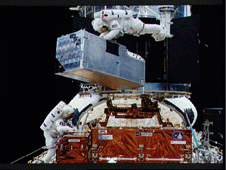July 30 2010 Vol. 3, Issue 7
Two seasoned systems engineers reflected on what it means to be a systems engineer at the Systems Engineering Leadership Development Program (SELDP) graduation.

Astronauts Kathryn C. Thornton (top) lifts the Corrective Optics Space Telescope Axial Replacement (COSTAR) prior to its installation on the Hubble Space Telescope on December 8, 1993. Astronaut Thomas D. Akers (below) assists with the installation. Credit: NASA
Jim Crocker, Vice President and General Manager at Lockheed Martin, and Robert Vitale, senior engineer at General Motors (GM), shared their stories and words of advice with the 2010 graduating class of the SELDP.
“I think the most important contribution that NASA has ever made has been in systems engineering,” began Crocker, who has worked on NASA projects such as the Hubble Space Telescope and GOES-R, and is currently working on the James Webb Space Telescope. While NASA didn’t invent systems engineering, he said, the agency has made critical contributions to the discipline.
Crocker reflected on his involvement in solving the spherical aberration problem on the Hubble Space Telescope (HST) and his work on the James Webb Space Telescope. Both taught him two key things: make sure you’re solving the right problem, and make sure you think things all the way through to the end.
While looking for solutions to the HST spherical aberration, Crocker realized that the optics weren’t the most pressing problem—it was more important to get the correction into the telescope. Once the team adopted this perspective, the Corrective Optics Space Telescope Axial Replacement (COSTAR) became possible by sacrificing the telescope’s high-speed photometer. “It’s so easy to get locked into solving the problem you know how to do,” Crocker said, “as opposed to solving the real systems engineering problem of understanding what problem you need to solve.”
Even after arriving at the right solution for the HST problem, Crocker and the team had to be able to sell the solution to everyone else. Critics offered myriad reasons why NASA couldn’t use the solution they had developed, Crocker recalled. The team had to think about all of the possible outcomes COSTAR would impose on HST and be prepared to defend their solution.
Robert Vitale, a senior research engineer for GM for 34 years, has been heavily involved in developing the vision of the automotive future. GM is changing what he calls the “DNA” of the automobile with cars like the Hy-wire, Sequel, and Electric Network Vehicles (ENV). Currently, cars are defined by petroleum fuel, mechanical controls, driver-dependency, and maximum cargo design. According to Vitale, the evolving DNA opens cars to hydrogen and electric power, semi- to fully-automated driving, “connectivity” (e.g., the Synch and OnStar systems), and tailoring for a specific use or consumer.
Starting in 1999, Vitale was part of a group that designed the GM Hy-wire. In 19 months, GM developed a first iteration of the vision for the next-generation of cars using technology available at the time. The Hy-wire consisted of a chassis (called the “skateboard”), exchangeable car bodies, electric and fuel cell power, and propulsion, breaking, and steering all in one unit. The second generation of this concept, the GM Sequel, is the roadworthy version of Hy-wire.
This fall GM will display their ENVs (imagine a two-wheeled Segway car) at a world expo in Shanghai, China. Vitale said that he has defined his career by “leaving the sandbox, jumping into the gravel pit, and pushing the boundaries.” Sometimes this means failing. “To fail is normal,” he said.
Sixteen systems engineers representing a cross-section of NASA centers graduated in the 2010 SELDP class.
Read more about SELDP.





